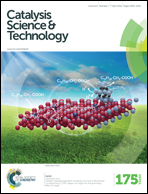Hollow AgPt/SiO2 nanomaterials with controlled surface morphologies: is the number of Pt surface atoms imperative to optimize catalytic performances?†
Abstract
We describe herein an investigation on how the number of Pt surface atoms and nature of exposed surface facets affect the catalytic performances of AgPt nanomaterials displaying controlled surface morphologies (smooth or rough surfaces), shapes (spherical or one-dimensional), and hollow interiors towards CO oxidation. More specifically, we focused on AgPt nanoshells (smooth surfaces), assembled nanoparticles (rough surfaces), nanotubes with smooth surfaces, and nanotubes with rough surfaces. We found that their catalytic performances followed the order: nanotubes with smooth surfaces > nanoshells, nanotubes with rough surfaces > assembled nanoparticles. The better catalytic activity observed for the nanoshells relative to the assembled nanoparticles can be associated with their higher number of Pt surface atoms. Even though the nanotubes with rough surfaces had a higher number of Pt surface atoms relative to the nanotubes with smooth surfaces, the latter displayed higher catalytic activities as a result of the preferential exposure of {100} facets, which are the most active towards CO oxidation relative to {111} and {110}. Interestingly, the nanotubes with smooth surfaces also displayed higher catalytic activities when compared to the nanoshells, showing that the preferential exposure of {100} side facets compensated the decrease in their number of Pt surface atoms relative to the nanoshells. Our data showed that the catalytic performances were strongly dependent on the surface morphologies, in which the preferential exposure of more active surface facets may play a significant role in the optimization of performances relative to the number of Pt surface atoms.


 Please wait while we load your content...
Please wait while we load your content...